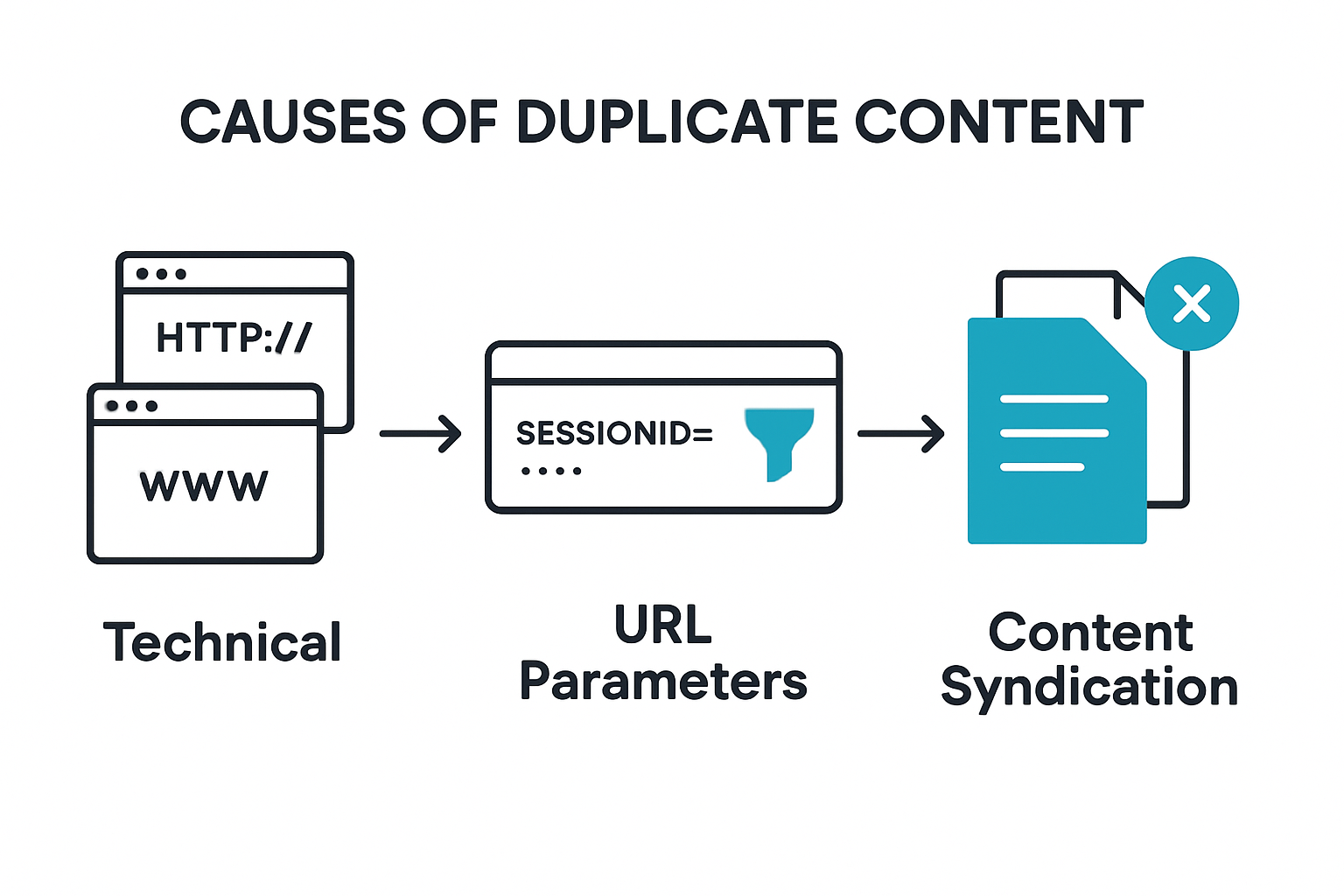Duplicate content seems harmless when you copy or repeat text across your site, and yet it can quietly upend your entire SEO performance. Search engines actually struggle with these repetitions, and over 25 percent of all web pages face duplicate content issues that can hurt their search rankings. Most people think only obvious plagiarism triggers problems, but simple URL structure mistakes or syndication can invite just as much trouble. The real impact lies in how fragments of identical content can drain your search power before you even notice.
Table of Contents
- Understanding Duplicate Content And Seo Impact
- Common Causes Of Duplicate Content Issues
- How Duplicate Content Affects Search Rankings
- Best Practices To Prevent And Fix Duplicate Content
Quick Summary
| Takeaway | Explanation |
|---|---|
| Duplicate content dilutes SEO performance | Content duplication spreads link equity and can cause lower search rankings. |
| Implement canonical tags for clarity | Use canonical tags to indicate preferred versions of duplicate pages to search engines. |
| Utilize 301 redirects for consolidation | Apply 301 redirects to direct users and search engines to a single content version, preserving link equity. |
| Create unique content to avoid duplication | Focus on generating distinctive content for each page to enhance organic visibility. |
| Monitor and manage technical configurations | Regularly audit site settings to prevent unintentional duplicate content generation from technical issues. |
Understanding Duplicate Content and SEO Impact
Duplicate content represents a significant challenge in search engine optimization that can dramatically impact a website’s visibility and performance. At its core, duplicate content refers to substantive blocks of content within or across domains that either completely match other content or are remarkably similar.
The Mechanics of Duplicate Content
Search engines like Google are designed to provide unique and valuable content to users. When multiple pages contain identical or near-identical content, search algorithms struggle to determine which version should be ranked. According to Northern Michigan University’s IT department, this content duplication can dilute ranking signals, effectively spreading the page’s potential search performance across multiple versions.
The impact goes beyond simple ranking challenges. Duplicate content can waste valuable crawl resources, meaning search engines might spend less time indexing the unique and potentially more important pages on your website. This resource allocation can result in incomplete site representation in search results, potentially reducing overall organic visibility.
SEO Consequences of Duplicate Content
The SEO implications of duplicate content are multifaceted and potentially severe. Search engines may respond to detected duplicate content through several mechanisms:
The table below organizes the main SEO consequences of duplicate content, summarizing each effect and its impact as described throughout the article.
| SEO Consequence | What Happens | Impact on Site |
|---|---|---|
| Ranking Suppression | Duplicate pages may be downranked or omitted | Lower search visibility, reduced organic traffic |
| Crawl Budget Reduction | Search engines waste crawl resources on identical pages | Fewer important pages get indexed |
| Link Equity Dilution | Backlinks and ranking signals are spread across pages | Weakens overall SEO performance |
| Indexing Limitations | Only one version might be indexed by search engines | Other duplicates don’t appear in search results |
| Algorithmic Consolidation | Search engines choose a preferred/canonical version | Non-preferred pages lose potential ranking value |
- Ranking Suppression: Search engines might choose to downrank or completely omit duplicate pages from search results.
- Crawl Budget Reduction: Search engines allocate a limited crawl budget to each website, and duplicate content can waste this precious resource.
- Link Equity Dilution: When multiple pages contain similar content, the potential link value gets spread thin, reducing the overall SEO performance.
Website owners must understand that duplicate content is not always intentional. Common scenarios include:
- Multiple URL variations pointing to the same content
- Printer-friendly versions of web pages
- Location or region-specific page duplications
- Syndicated content across multiple platforms
Addressing duplicate content requires a strategic approach. Read our comprehensive guide on preventing content cannibalization to develop a robust content strategy that maintains search engine optimization integrity.
Effective management involves implementing canonical tags, using 301 redirects, and creating truly unique content that provides distinct value to users. By proactively addressing duplicate content, websites can maintain their search engine rankings and ensure optimal crawl efficiency.
Common Causes of Duplicate Content Issues
Duplicate content emerges from various technical and strategic oversights that can significantly impact a website’s search engine performance. Understanding these root causes is crucial for developing an effective content management strategy.
To help clarify the most common sources of duplicate content issues, the table below summarizes each main cause along with a brief description and examples as mentioned in the article.
| Cause | Description | Example(s) |
|---|---|---|
| Technical Infrastructure Triggers | Duplicate content caused by site setup or configuration | HTTP vs. HTTPS, www vs. non-www, subdomains |
| URL Parameter and Tracking Complications | Duplicate content from URL parameters and tracking features | Session IDs, sorting/filtering, pagination |
| Content Syndication and Reproduction | Sharing or distributing content across multiple sites or platforms | Syndicated articles, reproduced blog posts |
| Mobile/Desktop Versions & Print Pages | Creating alternate representations of same content | Mobile/desktop pages, print-friendly pages |
| Location-Specific Duplications | Region or location-targeted pages duplicating core content | Region-specific service pages |
Technical Infrastructure Triggers
Websites often generate duplicate content unintentionally through technical configurations. According to Carnegie Higher Ed, one primary cause is websites being accessible under multiple protocol variations like HTTP and HTTPS without proper redirects. This means the same content can exist at different URLs, confusing search engine algorithms.
Wikipedia further explains that duplicate content can result from seemingly innocuous variations such as:
- Domain variations (with and without ‘www.’ prefix)
- Mobile and desktop page versions
- Different subdomain configurations
URL Parameter and Tracking Complications
Yoast identifies several nuanced scenarios that generate duplicate content through URL parameters. These include:
- Session ID Tracking: Unique identifiers added to URLs for user tracking
- Sorting and Filtering Parameters: E-commerce sites often create multiple URLs with identical core content
- Pagination and Print Versions: Creating alternate page representations
These technical configurations can exponentially multiply content versions without adding meaningful value, diluting search ranking potential.
Content Syndication and Reproduction Challenges
Content syndication presents another significant duplicate content risk. When the same article appears across multiple websites or platforms, search engines struggle to determine the original source. This can lead to ranking challenges and potential penalties.
Explore our comprehensive guide on preventing content overlap to develop a robust strategy for managing content uniqueness.
Mitigating duplicate content requires a proactive approach involving technical configuration, strategic content planning, and continuous monitoring. Website owners must implement canonical tags, utilize 301 redirects, and create distinctive, valuable content that serves unique user needs.

How Duplicate Content Affects Search Rankings
Duplicate content poses a significant threat to a website’s search engine performance, creating complex challenges that can dramatically reduce organic visibility and search rankings. The consequences extend far beyond simple content repetition, impacting how search engines evaluate and prioritize web pages.
Link Equity and Ranking Signal Dilution
Northern Illinois University highlights a critical issue with duplicate content: search engines struggle to distribute link equity when multiple pages contain identical or near-identical content. This means the valuable ranking signals that normally concentrate on a single authoritative page become fragmented across several versions, effectively weakening the overall search performance.
Search algorithms are designed to deliver the most relevant and unique content to users. When confronted with duplicate content, these algorithms must make complex decisions about which version to prioritize. This process often results in:
- Ranking Suppression: Pages with duplicate content may be pushed down in search results
- Indexing Limitations: Search engines might choose to index only one version of the content
- Reduced Crawl Efficiency: Valuable search engine crawl resources are wasted processing redundant content
Algorithmic Penalties and Content Evaluation
Modern search engines employ sophisticated mechanisms to detect and handle duplicate content. While not always resulting in direct penalties, these mechanisms can significantly diminish a website’s search visibility. Search algorithms may:
- Consolidate similar pages under a single representative URL
- Selectively choose the most authoritative version of the content
- Reduce the overall ranking potential for pages with substantial duplicate elements
Learn more about preventing content overlap strategies to maintain your website’s search engine optimization integrity.
The impact of duplicate content is particularly pronounced for websites with large content repositories or complex site structures. E-commerce platforms, news sites, and multi-regional websites are especially vulnerable to these challenges. Proactive management requires a comprehensive approach that includes technical optimization, content differentiation, and strategic URL management.
Ultimately, search engines reward websites that provide unique, valuable, and original content. By understanding how duplicate content affects search rankings, website owners can develop targeted strategies to maximize their organic search potential and maintain a strong digital presence.
Best Practices to Prevent and Fix Duplicate Content
Addressing duplicate content requires a strategic and proactive approach that combines technical implementation and content management techniques. Website owners must deploy multiple strategies to mitigate the risks associated with content duplication and maintain optimal search engine performance.
Canonical Tag Implementation
The University of California, Davis recommends using canonical tags as a primary method for managing duplicate content. These HTML tags explicitly tell search engines which version of a page should be considered the “master” or preferred version. When publishing original content, include a self-referential canonical tag pointing to the content’s URL. For content that might be duplicated, ensure the canonical tag directs search engines to the original source.
Key canonical tag strategies include:
- Adding self-referential canonical tags to prevent potential future duplication
- Specifying the preferred URL for pages with multiple variations
- Consolidating link equity to a single, authoritative page
URL Redirection and Consolidation
Google’s developer guidelines emphasize the importance of implementing 301 redirects to consolidate duplicate URLs. These permanent redirects ensure that:
- Users and search engines are directed to a single, preferred version of the content
- Link equity is preserved and concentrated
- Crawl resources are used more efficiently
Effective redirection involves:
- Mapping multiple URL variations to a single canonical URL
- Ensuring consistent internal linking to the preferred page version
- Updating XML sitemaps to reflect the consolidated URL structure
Content Differentiation Strategies
Explore our comprehensive guide on preventing content overlap to develop a robust content strategy that minimizes duplicate content risks. Proactive content management involves:
- Creating unique, valuable content for each page
- Avoiding unnecessary content repetition across your website
- Implementing clear information architecture
- Regularly auditing content to identify and resolve potential duplication issues
Website owners should also consider technical configurations that might inadvertently create duplicate content. This includes managing URL parameters, handling mobile and desktop versions, and controlling print-friendly page variations.
By implementing these best practices, websites can effectively prevent and mitigate duplicate content challenges, ensuring better search engine visibility and maintaining the integrity of their online content strategy.
The table below outlines best practices for preventing and fixing duplicate content, summarizing each method’s purpose and key actions based on the article’s recommendations.
| Best Practice | Purpose | Key Actions |
|---|---|---|
| Canonical Tag Implementation | Indicate preferred content version to search engines | Add self-referential canonicals, specify master pages |
| URL Redirection & Consolidation | Direct users/engines to a single URL, preserve link equity | Use 301 redirects, update internal links & sitemaps |
| Content Differentiation Strategies | Reduce repetition, increase page uniqueness | Create unique content, audit for duplicates, improve site architecture |
| Technical Configuration Management | Prevent accidental duplication from infrastructure | Manage URL parameters, handle mobile/print versions, control domains |

Frequently Asked Questions
What is duplicate content in SEO?
Duplicate content refers to substantial blocks of content within or across domains that match or are remarkably similar. This can occur when the same content appears on multiple URLs, diluting search engine ranking signals.
How does duplicate content affect my website’s SEO performance?
Duplicate content can lead to ranking suppression, waste crawl budget, dilute link equity, and limit indexing options for search engines, ultimately reducing your website’s visibility and organic traffic.
What are the common causes of duplicate content?
Common causes include technical infrastructure issues, URL parameter complications, content syndication across platforms, mobile vs. desktop versions of pages, and region-specific page duplications.
How can I fix duplicate content issues on my website?
You can fix duplicate content by implementing canonical tags to indicate preferred versions, using 301 redirects to consolidate URLs, and creating unique and valuable content for each page to avoid replication.
Take Control of Duplicate Content and Protect Your Rankings
Are you frustrated by how duplicate content eats away at your SEO efforts? If repeated blocks, diluted link equity, and wasted crawl budget sound like your daily headaches, you are not alone. Thousands of site owners face this exact challenge and risk losing search visibility because duplicate content confuses search engines and suppresses rankings. Keeping your website unique and streamlined is key to standing out and making the most of your hard work.
The good news is that you can solve these problems fast. Discover how the #1 Keyword Cannibalization Tool trusted by SEO professionals spots and fixes content overlap issues before they harm your site. Act now and see how easily you can identify duplicate content, clean up your site’s signals, and protect your position in search results. Visit RankAligner today to transform your SEO strategy and keep your site on top.
Recommended
- The Final Guide to Content Cannibalization in SEO (& How to Avoid)
- 15 Winning Hacks to Avoid Keyword Cannibalization Like a Pro
- 10 Keyword Cannibalization Mistakes That Are Killing Your SEO
- How to Exactly Fix Keyword Cannibalization to Improve Website SEO- Rank Aligner
- UX Testing Methods That Won’t Trigger Google Penalties
- Creating Searchable PDFs: Best Practices for 2025 Workflow – Mapsoft

